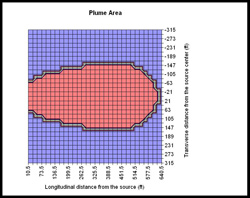Biofuels and Groundwater
Introduction
EPA researchers are investigating the impact of ethanol on the natural biodegradation of other gasoline constituents, including benzene, in groundwater. Researchers developed a model, called FOOTPRINT, as a simple and user-friendly computer application for estimating the extent of a benzene plume in case of an ethanol-blended gasoline spill. Biofuels, such as ethanol and biodiesel, are readily degraded in groundwater to produce methane at high concentrations. The methane can bubble out of the water and may achieve explosive concentrations in confined spaces or may carry vapors of hazardous fuel components (such as benzene) into inhabited spaces. EPA researchers are surveying gasoline service station sites with known spills of E10 gasoline to determine the prevalence in high concentrations of methane in soil gas above the spills. EPA scientists are also investigating the effects of the increased use of biofuels (such as ethanol) on the existing storage tank infrastructure and on potential groundwater contamination. Because of the corrosivity of ethanol and the use of the existing storage tank infrastructure, there is increased potential for leaks from existing gas stations and subsequent impacts on drinking water supplies. References and ProductsMackay, D., N. de Sieyes, M. Einarson, K. Feris, A. Pappas, I. Wood, L. Jacobson, L. Justice, M. Noske, J. Wilson, C. Adair, and K. Scow. (2007). “Impact of Ethanol on the Natural Attenuation of MTBE in a Normally Sulfate-Reducing Aquifer.” Environmental Science and Technology, 41, 6: 2015–2021. Mackay, D.M., N.R. de Sieyes, M.D. Einarson, K.P. Feris, A.A. Pappas, I.A. Wood, L. Jacobson, L.G. Justice, M.N. Noske, K.M. Scow, and J.T. Wilson. (2006). “Impact of Ethanol on the Natural Attenuation of Benzene, Toluene, and o-Xylene in a Normally Sulfate- Reducing Aquifer.” Environmental Science and Technology, 40, 19: 6123–6130. Computer ApplicationProjectsContactJohn Wilson Cherri Adair Ken Jewell
You will need Adobe Reader to view some of the files on this page. |
![[logo] US EPA](../gif/logo_epaseal.gif)


